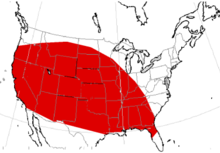- Osbornodon
-
Osbornodon
Temporal range: Early Oligocene–Early MioceneScientific classification Kingdom: Animalia Phylum: Chordata Class: Mammalia Order: Carnivora Family: Canidae Genus: †Osbornodon
Wang, 1994Type species †Osbornodon fricki Species - †O. brachypus
- †O. fricki
- †O. iamonenis
- †O. renjiei
- †O. sensoni
- †O. scitulus
- †O. wangi

Approximate range of Osbornodon based on fossil distribution Osbornodon ("Osborn's dog") is an extinct genus of bone-crushing canid (canidae) that were endemic to North America and which lived from the Orellan age of the Early Oligocene to Early Miocene epoch 33.9—15.97 Ma (AEO) and existed for approximately 17.93 million years. [1]
Contents
Taxonomy
Osbornodon was named by Wang (1994). Its type is Osbornodon fricki. It was assigned to Canidae by Wang (1994) and Munthe (1998).[2]
Morphology
Two fossil specimens were examined by Legendre and Roth for body mass. The first specimen was estimated to have weighed 22.2 kg (49 lb). The second specimen was estimated to have weighed 20.2 kg (45 lb).[3]
Genus
Seven known species of the genus Osbornodon existed:
- Osbornodon fricki (18 Ma)
- Osbornodon iamonensis (synonyms: Cynodesmus nobilis, Paradaphoenus tropicalis) (21 Ma), Osbornodon renjiei (33 Ma), and Osbornodon sesnoni (32 Ma).
Species
Osbornodon scitulus appears to be a transitional species that partially fills a large morphological and stratigraphical gap within the Osbornodon genus. Compared to Osbornodon renjiei and Osbornodon sesnoni, Osbornodon scitulus possesses derived characters such as large frontal sinus, high sagittal crest, narrow infraorbital canal, short bulla, and broad premolars. O. scitulus differs from Osbornodon wangi in larger size and relatively wider P3 and shorter P4. O. scitulus is distinguishable from Osbornodon iamonensis and later species in its primitive characters such as a non-elongated rostrum, paroccipital process that is not expanded posteriorly, mastoid process not reduced, and p4 not differentially enlarged relative to p3 (Wang, 2003).
References
- ^ Paleobiology Database: Osbornodon Basic info.
- ^ K. Munthe. 1998. Canidae. In C. M. Janis, K. M. Scott, and L. L. Jacobs (eds.), Evolution of Tertiary mammals of North America 124-143
- ^ S. Legendre and C. Roth. 1988. Correlation of carnassial tooth size and body weight in recent carnivores (Mammalia). Historical Biology 1(1):85-98
- R. M. Nowak. 1991. Walker's Mammals of the World. Maryland, Johns Hopkins University Press (edited volume) II (K. Behrensmeyer/K. Behrensmeyer/J. Alroy)
- Wang, X. 2003. New Material of Osbornodon from the Early Hemingfordian of Nebraska and Florida. Bulletin of the American Museum of Natural History, 279:163-176.
Extinct members of the family Canidae †Hesperocyoninae Hesperocyon · Mesocyon · Cynodesmus · Sunkahetanka · Philotrox · Enhydrocyon · Paraenhydrocyon · Osbornodon · Caedocyon · EctopocynusBorophaginae Archaeocyon · Borophagina · Borophagini · Oxetocyon · Otarocyon · Rhizocyon · Cynarctoides · Phlaocyon · Cormocyon · Desmocyon · Metatomarctus · Euoplocyon · Psalidocyon · Microtomarctus · Protomarctus · Tephrocyon · Paracynarctus · Cynarctus · Tomarctus · Aelurodon · Paratomarctus · Carpocyon · Protepicyon · Epicyon · BorophagusCaninae
(extinct genera)Chailicyon · Cynotherium · Dusicyon · Eucyon · Gobicyon · Leptocyon · Neocynodesmus · Nurocyon · Prototocyon · Theriodictis · XenocyonCaninae
(extinct species and subspecies)Canis apolloniensis · Canis armbrusteri · Canis cedazoensis · Canis dirus · Canis edwardii · Canis ferox · Canis lepophagus · Canis lupus hattai · Canis lupus hodophilax · Urocyon progressusCategoryThis article related to prehistoric animals from order Carnivora is a stub. You can help Wikipedia by expanding it.
